This Norwegian Fish Soup recipe (fiskesuppe) is a low-carb and gluten-free adaptation of the classic, a one-pot salmon chowder prepared in less than 30 minutes. It's ideal for those chilly, busy days!
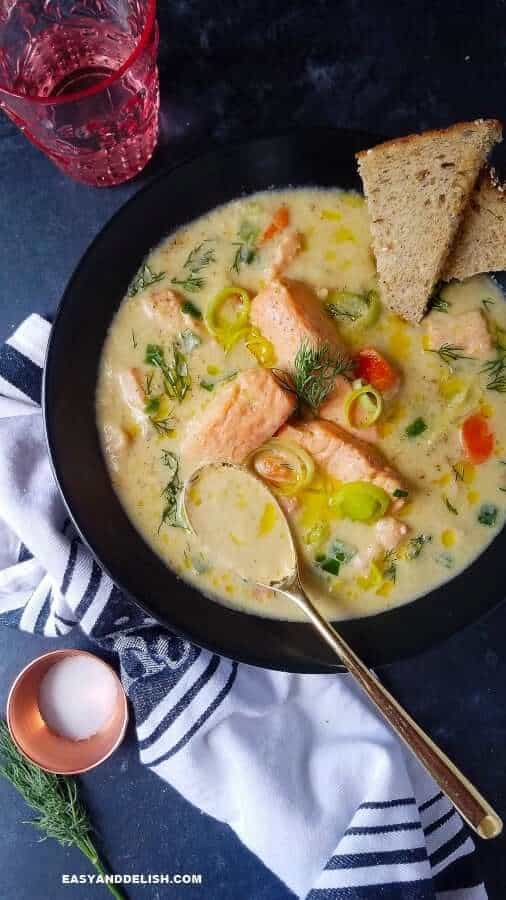
Watch our video to find out how to make This low-carb fish soup step-by-step!
Table of Contents
HOW TO MAKE NORWEGIAN FISH SOUP (FISKESUPPE)
This low-carb/GF fish soup recipe is easy to prepare!
On the Stovetop
- First, heat a large pot over medium heat. Add oil and cook onion and leek for about 3-4 minutes.
- Then, add garlic and cook for about 1 minute, stirring now and then. Do not let brown! Transfer about half of the veggies to the blender; reserve.
- Next, add broth and cauliflower to the pot and let cook over high heat for about 8-10 minutes or until tender. Transfer all the cauliflower and 1 cup of the broth to the blender. Add salt, pepper, cayenne pepper, and heavy cream. Blend with half of the reserved cooked veggies until smooth. Pour back into the pot.
- Add the fish and carrots. Let cook over medium-high heat for about 5-6 minutes. Remove the pot from the heat and stir in lemon juice.
- Last, garnish fish soup with fresh dill or chives. Serve by itself or with hard-crusted bread.
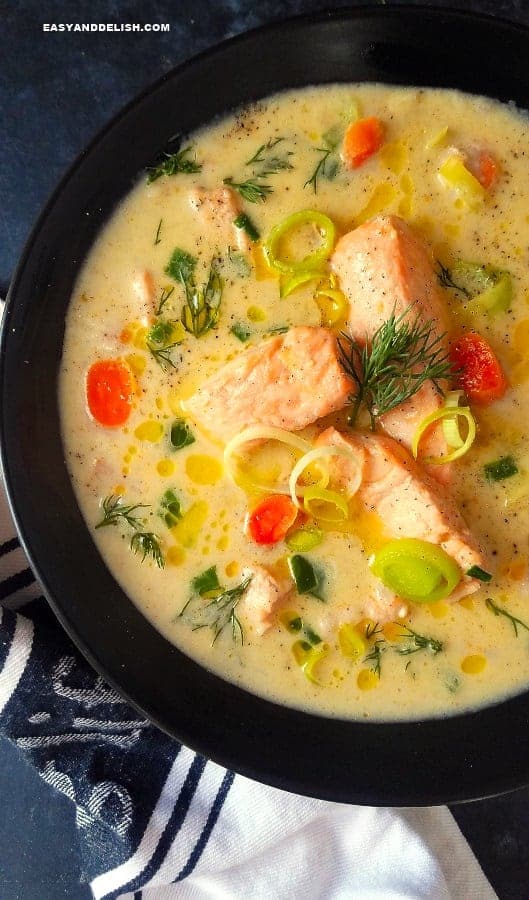
Making Salmon Soup (Instant Pot)
- Press the sauté button and heat the Instant Pot for about 3 minutes. Add oil and cook onion and leek for about 3-4 minutes.
- Then, add garlic and cook for about 1 minute, stirring now and then. Do not let brown! Transfer about half of the veggies to the blender and set aside.
- Add the broth and cauliflower to the pot, lock the lid, turn the valve to sealing, and let it cook over high pressure for about 4 minutes. Do a quick release!
- Transfer all the cauliflower and 1 cup of the broth to the blender. Add salt, pepper, cayenne pepper, and heavy cream. Blend with half of the reserved cooked veggies until smooth. Pour back into the pot.
- Add the fish and carrots. Press the sauté button and let cook for about 5-6 minutes. Cancel the sauté function and stir in lemon juice. Garnish the fish soup with dill.
ABOUT FISH SOUP RECIPE
I traveled to Norway to learn on-site all about its seafood and benefits, the great Norwegian fish industry, and their commitment to sustainability and preserving the environment.
Without a doubt, this trip changed my perspective for the better and has already impacted the way that I eat every day. I hope that it will do the same for you, too!
I visited the cities of Alta, Tromso, and Oslo, and would love to share with you a fish dish recipe I enjoyed a lot there: A fish soup (fiskesuppe) made with salmon.
However, I adapted the traditional Norwegian fish soup to a low-carb diet. This means, that instead of using potatoes I used cauliflower to thicken the broth.
Because the soup is chunky, you can say this is a salmon chowder, not a bisque.
Ingredients for Salmon Chowder
- Olive oil – You may use butter instead or a combination of olive oil and butter.
- Vegetables – I used onion, leeks, garlic, and cauliflower because I am making the low-carb version. The classic fiskesuppe also uses parsnips or potatoes instead of cauliflower as well as carrots and celery.
- Fish broth – A vegetable broth makes a great replacement!
- Seasonings – salt, pepper, and cayenne for a kick. But you can use curry powder if you prefer!
- Heavy cream – To add a velvety creaminess to the broth. Greek yogurt would be a suitable substitute.
- Salmon – My first choice because it is meaty and firm but cod, haddock, or wolfish would work well in this fish soup.
- Lemon juice – To give a touch of acidity and bring all the flavors together.
- Dill – it complements well the salmon but you can use chives instead.
NOTE: Some add wheat flour and egg yolk to the fish soup to make it thicker and creamier. Blending the cauliflower until smooth and adding the cream are enough to thicken the broth and make it creamy.
Type of Fish for This Fish Chowder
Salmon is my first choice because of its omega-3 fatty acids and also because it is meaty and firm enough to hold its shape after cooking. But cod, haddock, or wolffish will work well too in this Norwegian fish soup.
When making a fish chowder, avoid:
- Delicate fish – It falls apart after cooking. Firm to moderately firm fish is what you should look for.
- Lean fish – They will be a little dry after cooking such as mackerel and swordfish.
Can you use frozen fish in this fish soup recipe?
Although I prefer to use fresh fish (or thawed overnight in the fridge), you can use frozen salmon or other fish in our fish soup. It will take a little longer to fully cook in the soup (about 3- 5 minutes longer than the usual 5-6 minutes).
How to Store Fish Soup
- Store leftovers in an airtight container in the fridge for up to 3 days. Freeze for up to 4 months. It is one of those easy freezer recipes!
- Thaw in the fridge overnight. Reheat gently over low heat, stirring once and a while, until hot. Because it contains cream, the creamy broth may break apart a little just like our corn chowder.
MORE SEAFOOD RECIPES
Besides this fish soup, enjoy these other recipes:
- Easy Grilled Salmon
- Air Fryer Salmon
- Teriyaki Salmon
- Fish Pie
- Moqueca recipe
- Shrimp in Coconut Sauce
- Baked Blackened Salmon
- Shrimp soup
- Italian baccala
Norwegian Fish Soup Recipe (Fiskesuppe)
Equipment
- Pot or Instant Pot
- blender
Ingredients
- 2 tablespoon olive oil
- 1 white or yellow onion small diced
- 1 cup leek stalk (1 green leaf chopped and 1 cup white stalk sliced)
- 4 garlic cloves minced
- 4 cups fish broth or stock
- 1 lb cauliflower frozen or fresh
- salt and pepper to taste (about 1 and ½ teaspoon salt, and ½ teaspoon pepper)
- ¼ teaspoon cayenne pepper
- 1 cup heavy cream
- 1 lb salmon skinless and cut into chunks
- 1 carrot (OPTIONAL) peeled and cut into small chunks (skip if on a KETO diet)
- 1 lemon juiced
- 1-2 tablespoon fresh dill or chives chopped
Instructions
- STOVETOP: Heat a large pot over medium heat. Add oil and cook onion and leek for about 3-4 minutes. Then add garlic and cook for about 1 minute, stirring every now and then. Do not let brown! Transfer about half of the veggies to a blender cup; reserve.
- Add broth and cauliflower to the pot and let cook over high heat for about 8-10 minutes or until tender. Transfer all the cauliflower and about 1 cup of the broth to the blender with salt, pepper, cayenne, and heavy cream. Blend with half of the reserved cooked veggies until smooth. Pour back into the pot.
- Add the fish and carrots. Let cook over medium-high heat for about 5-6 minutes. Remove pot from the heat and stir in lemon juice. Garnish top of soup with fresh dill or chives. Serve fish soup by itself or with a hard-crusted bread.
- INSTANT POT: Press the sauté button and heat the Instant Pot for about 3 minutes. Add oil and cook onion and leek for about 3-4 minutes. Then, add garlic and cook for about 1 minute, stirring every now and then. Do not let brown! Transfer about half of the veggies to the blender and set aside.
- Add the broth and cauliflower to the pot, lock the lid, turn the valve to sealing, and let it cook over high pressure for about 4 minutes. Do a quick release!
- Transfer all the cauliflower and 1 cup of the broth to the blender. Add salt, pepper, cayenne pepper, and heavy cream. Blend with half of the reserved cooked veggies until smooth. Pour back into the pot.
- Add the fish and carrots (optional). Press the sauté button and let cook for about 5-6 minutes. Cancel the sauté function and stir in lemon juice. Garnish the fish soup with dill.
Recipe Video

Recipe Notes
Nutrition
** Nutrition labels on easyanddelish.com are for educational purposes only. This info is provided as a courtesy and is only an estimate, since the nutrition content of recipes can vary based on ingredient brand or source, portion sizes, recipe changes/variations, and other factors. We suggest making your own calculations using your preferred calculator, based on which ingredients you use, or consulting with a registered dietitian to determine nutritional values more precisely.
Please note that health-focused and diet information provided on easyanddelish.com is for educational purposes and does not constitute medical advice, nor is it intended to diagnose, treat, cure, or prevent disease. Consult with your doctor or other qualified health professional prior to initiating any significant change in your diet or exercise regimen, or for any other issue necessitating medical advice.
Fish Soup Recipe was once a sponsored post written by me on behalf of the Norwegian Seafood Council. I updated it for culinary purposes!


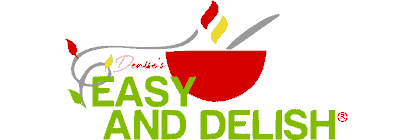
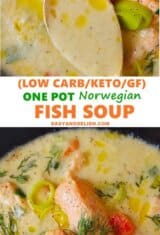
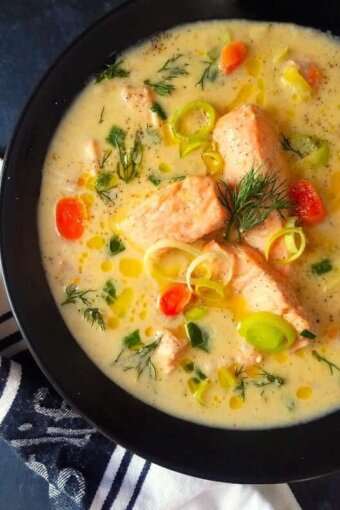
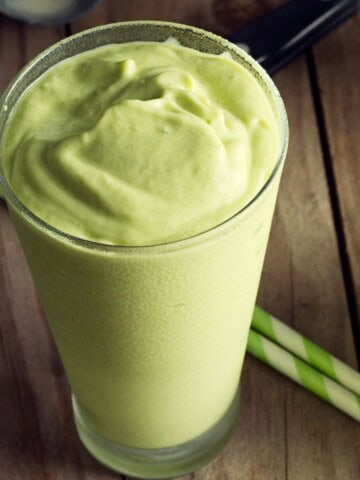
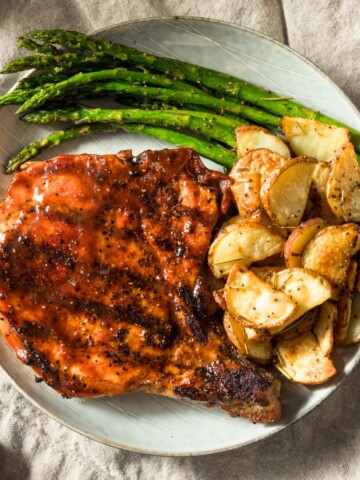

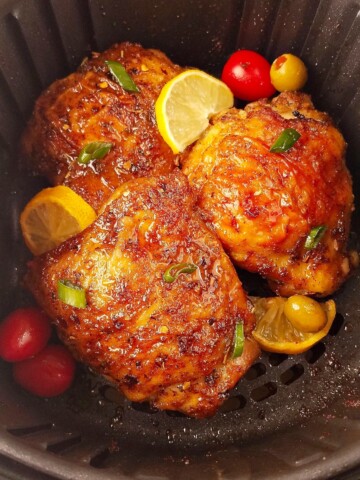
Laurie says
OMG! This soup is all kinds of wonderful and I’m not a huge salmon fan. Husband (the huge salmon fan) gave it a raving review too. We will definitely put this into the soup rotation.
Denise Browning says
Wow Laurie! I feel so happy you and your husband loved this fish soup. I had a similar one when I visited Norway a few years ago. So when I got back, I tried my best to make a similar one, except this is low-carb. The original has potatoes instead of cauliflower. Thank you so much for your feedback.
Victoria says
Yes! I have been looking for a low-carb salmon chowder recipe for a while! This sounds crazy, but I recently discovered that RADISHES totally resemble potatoes in soup! So I now use radish instead of cauliflower in my soups haha
Denise Browning says
Hi Victoria! The cauliflower in this chowder replaces potatoes and makes the soup creamy. Please do not replace cauliflower with radishes because they taste quite different and won't make the soup creamy at all. It will ruin the flavor of this soup to say the truth.
Patra says
Too YUMMY to explain! And note: you may use Barista style oat milk. EVERYONE in my home absolutely LOVES this soup!!
globalsubwaylistens.com says
Thanks for sharing the norwegian fish soup recipe. Will surely try this at home.
Denise Browning says
My pleasure! This fish soup is quick to amke and so nutritious.
restaurantthatdeliversnearme.website says
Thanks for the norwegian fish soup recipe.
Denise Browning says
The pleasure is mine. I enjoyed thois healthy fish soup a lot.
Walter says
Yummy! Thanks for the recipe. I used 1/2 cup of cream and still delicious. Also, I added a stalk of celery and 1 cup mushrooms. Instead of Cayenne I like to use Chipotle. Simply delicious on a cold fall day.
Denise Browning says
Hi Walter! I am glad you enjoyed our Norwegian fish soup. It is indeed an easy, quick, and healthy dinner recipe. Because our version is also low carb, I can eat it without guilt. Love your customization ideas. Have a great week!
Steph says
I’ve been wanting to make this ever since I came hone from Norway. So yummy! Thanks!
Denise Browning says
Hi Steph! I am so glad you enjoyed this fish soup. It is an adaptation of the classic made low carb. It was one of my favorite dishes when I visited Norway last year. I miss that gorgeous country! Thanks for the review.
Tryna says
I am on a low carb diet and saw this fish soup recipe on Pinterest. Oh boy it was so delicious. Next time I am making more and freezing.
2pots2cook says
Love those guys and the way they prepare fish... Thank you dear 🙂 Enjoy your weekend !
Mimi says
This looks so lovely. Light but really flavorful. And I have salmon in my freezer!
John / Kitchen Riffs says
Yum! This looks SO good and incredibly healthy. Really great recipe -- thanks.